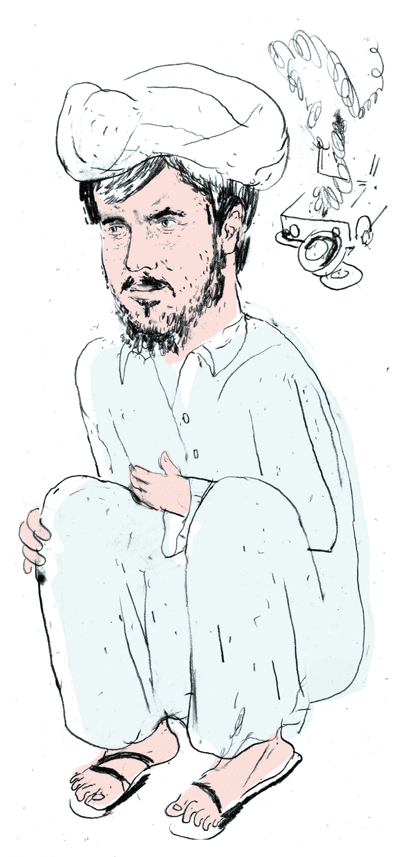Interview: Globe and Mail Afghanistan correspondent Graeme Smith
Paul McLaughlinWebsite

Globe and Mail Afghanistan correspondent Graeme Smith. Illustration by Peter Mitchell.
Calgary Herald reporter Michelle Lang was the first Canadian journalist to die covering the conflict in Afghanistan. She was killed on December 30, 2009. Her death brought to mind the dangers faced there not just by the military but by the media as well. From September 2005 to February 2009, Globe and Mail reporter Graeme Smith, now 30, did 16 tours in Afghanistan, each one lasting seven weeks on average. We spoke to him in Toronto where he’s working on a book about his experiences in the troubled country.
This: You were there a lot.
Graeme Smith: The line I use in my bios is that I spent more time in southern Afghanistan than any other Western journalist during those years. I volunteered [to do the numerous tours] not realizing that nobody in their right mind does that.
This: Why?
Smith: It’s pretty intense. I came out of those stints exhausted and dusty and tired and sometimes sort of shaken. After almost a year back in Canada I feel almost human again.
This: What was it like when you first arrived?
Smith: It was fairly benign in September 2005. I drove down the highway from Kabul to Kandahar in a civilian vehicle. I didn’t even bother to put on my disguise—Afghan clothing. The only security advice my local staff gave me was “please avoid wandering the streets at night.”
This: But that changed.
Smith: The following year it became too dangerous to drive in a car. The Taliban and the bandits had started setting up checkpoints on the highway. When I travelled by bus I dressed up like a tribesman with a big long beard and an Afghan outfit and I didn’t speak at all because we didn’t want the other passengers to know that I was a foreigner in case the bus was stopped and searched. Probably most importantly, I changed the way that I walked. Afghans told me I walked like a foreigner with my arms swinging and a purposeful stride. Kandaharis saunter, often with their hands behind their back in a thoughtful, professorial pose.
This: What was a low point for you?
Smith: I had a very hard spring in 2007. Three masked gunmen kicked in the door of the Globe and Mail’s little office in Kandahar City and searched the place and beat up the cook, who was the only guy there. That was the spring when I did the interviews with the Afghan detainees [who had been transferred by Canada to jails where they were tortured] and also when I was with some British troops and we got into a very nasty ambush, to a point where the troops wanted to give me a gun. It was a frightening time. I decided then I couldn’t spend my career in Afghanistan. I couldn’t invest that much emotionally in a place that was so unpleasant.
This: But you kept going back.
Smith: Yeah. It was like a book you couldn’t put down. You always wanted to turn the page and see what happened next.
This: What was the fascination?
Smith: It felt like a place that was drastically underserved by the world’s media. Reporters Without Borders has called southern Afghanistan a “black hole.” A lot was happening and very little was getting reported. I still feel my reporting just scratched the surface of what was going on.
This: How dangerous did it become for you?
Smith: I made it dangerous for myself in the end. My last story was about General Mohammed Daud Daud, the deputy minister of the interior with special responsibility for counter narcotics. I accused [him] of being a drug dealer. I then fled the country. By the time he read the article and went to find me and my translators, I was safely on a beach in the Caribbean.
This: Any memories that haunt you?
Smith: A lot of things. A couple of times, I got bits of charred human flesh stuck in the treads of my shoes as I was covering suicide bombings. That always bothered me. More broadly, I’m haunted by the failure of the world’s most powerful armies, and the wealthiest countries in the history of human civilization, as they attempted to improve conditions in a backwater state in the mountains of South Asia.